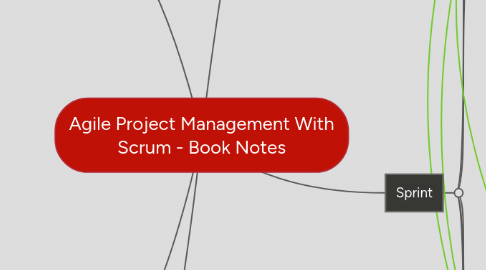
1. Empirical Process
1.1. Def
1.1.1. Visibility
1.1.2. Inspection
1.1.3. Adaption
2. Roles
2.1. Scrum Master
2.1.1. Teaches scrum to other members
2.1.2. Ensures the scrum process is followed and successful
2.2. Product Owner (PO)
2.2.1. Represents the interests of the stakeholders
2.2.2. Provides initial overall requirements
2.2.2.1. Product Backlog
2.2.2.1.1. Always changing
2.2.2.1.2. Initial estimates and priorities
2.2.2.1.3. Dynamic, always updating and changing
2.2.2.1.4. Large Printout in team area so everyone knows the goals and progress
2.2.3. Focused on Return on Investment (ROI)
2.3. Team
2.3.1. Responsible for developing functionality
2.3.2. Self managing and self organizing
2.3.3. Responsible for success of each iterration
2.4. All role members have authority in each area
2.4.1. Committed to the project
2.4.1.1. Those not committed cannot intefere
2.5. Pigs and Chickens analogy
2.5.1. Pig and Chicken discuss opening a restaraunt
2.5.1.1. Only going to serve Ham and Eggs
2.5.1.1.1. Thus the pig is the only real committed role
2.5.1.1.2. Chicken desires the project to be successful, but has no real work to do and isn't on the hook for its success
3. Sprint
3.1. 30 Day Iteration
3.2. Sprint Planning Meeting
3.2.1. Time Boxed: 8 Hours Maximum
3.2.2. Product Owner and Team meet to discuss what will be done for the next sprint
3.2.2.1. Chosen based off priority of the Product Backlog
3.2.2.2. Team should practice communication skills with the Product Owner to speak about business not technically
3.2.3. 2 Parts
3.2.3.1. First 4 hours
3.2.3.1.1. Work with PO to update/ add to and prioritize Product Backlog
3.2.3.2. Second 4 hours
3.2.3.2.1. Team creates a plan to work off agreed upon tasks
3.2.3.2.2. Marks the beginning of the 30 day sprint
3.3. Daily Scrum
3.3.1. Every Day
3.3.1.1. 15 min
3.3.2. Answer Three Questions
3.3.2.1. What have you done since the last scrum
3.3.2.2. What you plan on doing until the next scrum
3.3.2.3. What roadblocks you have for this sprint or the project
3.3.3. Synch up team and schedule any meetings needed to forward its progress
3.3.3.1. find out what is behind and if all tasks are going to be finished
3.3.4. Mention detail
3.3.4.1. Do NOT say 'bug fixes'
3.3.4.1.1. state which bug, in what code
3.3.5. Find out who needs help
3.3.5.1. schedule help asap
3.4. Sprint Review
3.4.1. Time Boxed: 4 Hours
3.4.2. Team presents what was developed to the Product Owner
3.4.2.1. Other stakeholders can attend
3.5. Sprint Retrospective Meeting
3.5.1. Time Boxed: 3 hours
3.5.2. ScrumMaster encourages the Team to revise, within the Scrum process framework and practices,
3.5.3. Each team member states what worked in the sprint and what needs to be improved
4. Complex Projects
4.1. Scrum of Scrums
4.1.1. One member from each team meets for a separate daily scrum
4.2. Part time team members
4.2.1. A team member from one team will take part in other team's daily scrums to coordinate dependencies. This makes them a part time team member.
4.3. Sprint Review Meetings can be mixed as a demo day
4.3.1. Should replace formal documentation and reporting on the sprint
4.4. Scaling Scrum
4.4.1. Adding Number of Teams
4.4.1.1. Sprints to setup archiecture required before scaling teams
4.4.1.2. New teams are seeded with a member of original team
4.4.2. Non functional scaling requirements need to be added to product backlog
4.4.2.1. Staging
4.4.2.1.1. Decompose business architecture to support clean-interface multi- team development
4.4.2.1.2. Decompose system architecture to support clean-interface multi- team development.
4.4.2.1.3. If necessary, define and implement a development environment to support multi-team collocated or distributed environments.

